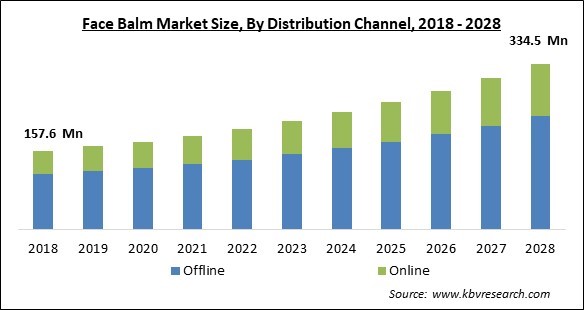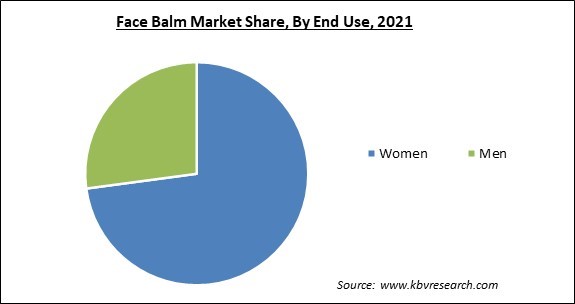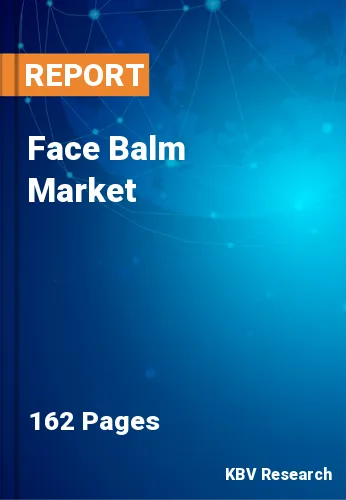The Global Face Balm Market size is expected to reach $334.5 Million by 2028, rising at a market growth of 8.7% CAGR during the forecast period.
Face balm is a type of thick balm that is used to nourish, heal, and protect the skin on the face. There are many different face balm formulations available to treat different skin types and skin issues. Face balms are frequently gender-neutral, but those that do contain fragrance are designed to appeal to both men and women who enjoy different kinds of scents. The weight and thickness of the face balm allow it to be identified from other forms of moisturizers.

The strongest moisturizer is usually a balm, which is made of wax or oil and normally doesn't include any water. In order to address blemishes, abrasions, and skin damage brought on by aging, exposure to the sun or weather, and other reasons, face balms are applied to the skin. In order to give the face a more beautiful appearance, face balms are also used as face cleaners. Face cleansing products help remove unwanted dead cells and impurity materials by clearing the cell pour as they are being used. To improve facial beauty, cleansing balms moisturize and nourish the skin.
The predicted growth of the face balm market is due to the proliferation of the product's demand on a global scale. Additionally, as the waterless beauty trend gains hold, sales of cosmetics have soared. Independent companies have done a lot to advance the idea of waterless cosmetics. Positive consumer reactions further encouraged luxury and mass-market businesses to broaden their business horizons in waterless beauty, which in turn fueled the face balm industry's expansion.
Additionally, appealing marketing strategies and new packaging trends are the main factors driving the face balm market demand. Additionally, using natural ingredients in the creation of skin-safe cosmetics and facial care products is a frequent strategy employed by manufacturers to attract more clients. This helps to increase the revenue of companies operating in this industry. The makers' collaborative employment of these techniques has led to an increase in market trends for face balm.
In many parts of the world, the COVID-19 pandemic compelled an immediate lockdown to stop the virus from spreading, leading to the swift shutdown of factories, stores, and other businesses. Travel restrictions and a sharp decline in demand and supply have hurt the market for non-essential goods. Due to a manpower scarcity brought on by the global lockdown, manufacturers of skincare products were forced to close their production facilities. Additionally, a lot of cosmetics stores had to close due to the pandemic. Retail store closures brought about by severe lockdown measures also had disastrous effects, with sales falling by a significant amount. As consumers spent less on cosmetics and personal care items, businesses positively addressed the situation by expanding their production capabilities and providing hand sanitizers and cleaning supplies.
Research and development (R&D), as well as advertising and promotions, are what drives the whole cosmetics business. Key parties are making significant investments in these components to affect customer purchasing behavior and raise product appeal in the retail environment. Additionally, the growing use of the internet in underdeveloped countries has changed how major corporations approach their advertising budgeting. The "major shift" that the main players are undergoing is causing them to spend more on advertising and promotions in reaction to the globalization of society. During the projection period, all of this is expected to assist the market expansion around the world.
There are many topical treatments like balms that treat or stop the signs of ageing. Retinol is crucial for minimizing the effects of ageing. Retinol, an active form of vitamin A, is another type that can be detected. By replenishing vitamin, A in the body, retinol and retinoic acid aid to improve cell regeneration, build collagen, lessen discoloration, and repair wrinkles. Another key ingredient in anti-aging skincare products, antioxidants support skin healing and repair in aged skin. However, prevention is the main anti-aging benefit. During the projection period, all of this is expected to assist the market expansion around the world.
A decent face cream will often cost a little bit more, but certain well-known brands have been in the facial skincare business for a long time because of their excellent outcomes. The user may experience skin irritation and dryness when they use the wrong face balm or when it's difficult to discover one that's perfect for them. Some facial balms have oils in them that stop water from evaporating, which can clog pores and lead to acne. These oils include petrolatum and lanolin. All of this may limit the use of face balms and hence limit market expansion.
Based on application, the face balm market is categorized as commercial and residential. The residential segment held the highest revenue share in the face balm market in 2021. As people become increasingly aware of the advantages of using face balms, household use of cosmetics for personal use is increasing. Customers have been urged to use face balm every day to shield their skin from damage caused by dust, air pollution, and direct sun exposure. Worldwide, the personal use of people by individuals dominates a sizeable percentage of the cosmetics industry.

On the basis of end use, the face balm market is segmented into men and women. The men segment recorded a significant revenue share in the face balm market in 2021. The market for men's skincare is expanding mostly due to rising disposable income, product releases, celebrity endorsements, and male consumers' increasing awareness of personal cleanliness and regular grooming. As a result, men are increasingly interested in specialty skincare products like anti-aging and sun protection creams in addition to more general grooming essentials like deodorants, razors, and face wash. In the near future, men's demand for sunscreen and anti-aging products is anticipated to increase significantly.
Based on distribution channel, the face balm market is divided into online and offline. The offline segment generated the maximum revenue share in the face balm market in 2021. Manufacturers consistently strive to increase the visibility of their products on store shelves; as a result, they concentrate primarily on offline sales. As a result, face balms and other facial care products are available offline in greater numbers. Additionally, the market is expanding as a result of the widespread accessibility of face balms at offline cosmetic stores.
| Report Attribute | Details |
|---|---|
| Market size value in 2021 | USD 188 Million |
| Market size forecast in 2028 | USD 334.5 Million |
| Base Year | 2021 |
| Historical Period | 2018 to 2020 |
| Forecast Period | 2022 to 2028 |
| Revenue Growth Rate | CAGR of 8.7% from 2022 to 2028 |
| Number of Pages | 162 |
| Number of Tables | 318 |
| Report coverage | Market Trends, Revenue Estimation and Forecast, Segmentation Analysis, Regional and Country Breakdown, Companies Strategic Developments, Company Profiling |
| Segments covered | Application, Distribution Channel, End Use, Region |
| Country scope | US, Canada, Mexico, Germany, UK, France, Russia, Spain, Italy, China, Japan, India, South Korea, Singapore, Malaysia, Brazil, Argentina, UAE, Saudi Arabia, South Africa, Nigeria |
| Growth Drivers |
|
| Restraints |
|
On the basis of region, the face balm market is analyzed across North America, Europe, Asia Pacific, and LAMEA. The Asia-Pacific region led the face balm market by generating maximum revenue share in the face balm market in 2021. With a highly developed infrastructure and a sizable research and development base, the region will be able to control the global market in terms of revenue for the predicted amount of time. The worldwide cosmetics industry is one of the most diverse and active markets. Skin care, sun protection, moisturizers, and various types of face balms are some of the most popular cosmetic product categories in the region.
Free Valuable Insights: Global Face Balm Market size to reach USD 334.5 Million by 2028
The market research report covers the analysis of key stake holders of the market. Key companies profiled in the report include Unilever PLC (REN Clean Skincare), L'Oreal Group (CeraVe), Weleda AG, Pangaea Holdings, Inc., Naturium, Pinch of Colour LLC, UpCircle Beauty, and W.S. Badger Company, Inc.
By Application
By End Use
By Distribution Channel
By Geography
The global Face Balm Market size is expected to reach $334.5 Million by 2028.
Rising expenditure from major market players are driving the market in coming years, however, Side effects of using low grade products restraints the growth of the market.
Unilever PLC (REN Clean Skincare), L'Oreal Group (CeraVe), Weleda AG, Pangaea Holdings, Inc., Naturium, Pinch of Colour LLC, UpCircle Beauty, and W.S. Badger Company, Inc.
The expected CAGR of the Face Balm Market is 8.7% from 2022 to 2028.
The Women segment acquired maximum revenue share in the Global Face Balm Market by End Use in 2021 thereby, achieving a market value of $238.1 Million by 2028.
The Asia Pacific market dominated the Global Face Balm Market by Region in 2021, and would continue to be a dominant market till 2028; thereby, achieving a market value of $124.4 Million by 2028.
Our team of dedicated experts can provide you with attractive expansion opportunities for your business.

